Child Labor: The Cause Can Also be a Cure
Child Labor: The Cause Can Also be a Cure
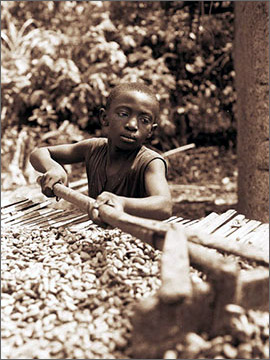
WASHINGTON: Many chocolate lovers still have a bitter taste in their mouths from revelations that the candies they adore might have been produced by child labor in West Africa. In an ensuing uproar, cocoa producers, traders, suppliers, governments, unions and civil-society groups agreed to a solution brokered by two members of Congress. In 2001, they created a multi-sectoral partnership, the Cocoa Protocol, to address the conditions that perpetuate forced child labor on these cacao plantations.
Yet five years later, children still toil, picking cacao in unsafe and unfair conditions. Clearly, a sector-specific strategy cannot address the broad cultural, social and economic factors in West Africa that perpetuate child labor.
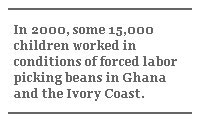
The number of children forced to labor in the cacao plantations is small. In 2000, the US State Department, Knight Ridder and the BBC reported that some 15,000 children worked in conditions of forced labor picking beans in Ghana and the Ivory Coast. Trafficked from extremely poor countries, like Mali and Burkina Faso, the children worked on some of the 1.5 million small cocoa farms in West Africa. These farms produce more than half the world’s cacao that’s processed into candy, cookies or cocoa butter used for cosmetics.
Consumers and regulators don’t know how to protect these child workers without jeopardizing the livelihoods of millions of their compatriots.
The news that forced labor was used to produce chocolate, a clear violation of existing legislation, raised a red flag for US policymakers as well as processors and manufacturers of cocoa products. Under the Smoot-Hawley Tariff Act of 1930, the US Customs Service is supposed to refuse entry to any goods identified as made by forced labor. But it rarely investigates or interdicts such products. Congressman Elliott Engel and Senator Tom Harkin pursued a new tactic. The House passed legislation requiring the US Food and Drug Administration to develop a social label to reassure consumers that their cocoa products were free of child labor.
However, before the Senate could act, a panicked chocolate industry appealed for a non-legislative solution. The industry feared the US chocolate market, with some $13 billion in sales, would collapse if the bill became law.
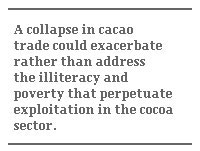
Harkin and Engel wanted to address child labor without undermining the fragile economies in question. They recognized that in the Ivory Coast alone, some 7 million individuals were engaged in cacao-related economic activity; but less than 1% of these workers were children. They also understood that a collapse of this trade could exacerbate rather than address the root factors – illiteracy, poverty and lack of economic alternatives – that perpetuate exploitation in the cocoa sector.
In September 2001, after intense negotiations, plantation owners, cacao traders and processors and chocolate manufacturers agreed to implement the Cocoa Protocol. All of the major chocolate company firms signed on and agreed to work with unions, civil society and government officials in a multi-sectoral partnership designed to ensure that all cocoa bean products are grown and processed without violating international accepted labor standards. Moreover, the signatories to the Protocol agreed to develop and put in place a certification to assure consumers that processed cacao was not produced in these conditions by July 1, 2005.
But the companies did not meet that deadline. They were hampered by civil war in the Ivory Coast and the non-participation of companies that use cacao for cocoa butter products such as cosmetics firms.
After an in-depth investigation of conditions of cacao plantations in Ivory Coast in 2006, BBC reporter Humphrey Hawksley found little evidence that industry efforts were changing farm conditions and concluded: “No one is in charge of the efforts put in place under the Cocoa Protocol. There's no place the buck stops. In the cocoa belt, it's only a short drive to find children working with machetes amid some of the worst poverty anywhere in the world."
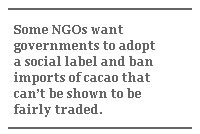
Some NGOs and activists are frustrated and want to abandon the Protocol. The International Labor Rights Fund filed suit against Nestlé, ADM and Cargill. Meanwhile, other NGOs such as Global Exchange want governments to adopt a social label and ban imports of cacao that can’t be shown to be fairly traded. But a government approved or sanctioned social label is not a panacea. Although some countries, namely Belgium and South Africa, have put in place social labels for manufactured goods, they have not done so for bulk commodities such as cacao where it is difficult to separate out those commodities legitimately produced and those not. Moreover, policymakers don’t yet know if such social labels could be challenged as a trade distortion at the WTO. In the face of these concerns, the two legislators as well as some NGOs such as Free the Slaves and the National Child Labor Coalition are willing to wait another year for the chocolate industry to develop its certification.
Forty-two countries in the chocolate supply chain endorsed the protocol and abide by its strictures. Industrialized country governments, international organizations, chocolate companies and foundations provide money and expertise to resolve complex problems in the sector. Under the watchful eye of Protocol participants, Ghana and the Ivory Coast have stepped up efforts to monitor labor conditions, reduce or eliminate school fees, and invest in the education of local children. Meanwhile, in countries such as Mali that have exported child labor, government officials teach families how they can raise family incomes if they let their kids go to school. These efforts are beginning to address the supply-side factors that can perpetuate forced child labor in the cocoa sector, while pushing cocoa processors and manufacturers on the demand side to stop procuring cacao from farms where forced child labor exists. And the changes do not undermine the cacao trade that sustains so many West Africans.
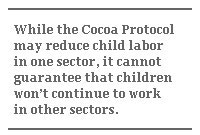
But a sector-specific strategy cannot address the economic and cultural factors that perpetuate forced child labor in West Africa: First, because of an oversupply of cacao, the real price of cacao remains low by historic standards. West African farmers have little leverage to bargain effectively for higher prices and thus they try to reap cost efficiencies from their workers. Secondly, the Protocol cannot address the cultural mores that perpetuate child labor in the countries of West Africa. Lacking educational opportunities, parents view their children as an extra hand, not as individuals who deserve time for education or play. Childhood is both a construct and a luxury good, available only to children of adults who earn sufficient livelihoods for their families as a whole.
Consequently, while the Cocoa Protocol may reduce child labor in one sector, it cannot guarantee that children won’t continue to work in other sectors. Their exploitation will only stop when policymakers in the industrialized and developing world meet their human-rights obligations and enforce the law; when companies take responsibility for their supply chains and develop strategies to ensure that their suppliers don’t rely on forced labor; and finally, when policymakers address the lack of opportunities, power, and education as well as cultural mores that allow individuals to be abused. The Cocoa Protocol offers a model as to how policymakers working in collaboration with industry, unions and civil society, might address these problems in one sector without distorting trade. But it’s just a sector-specific start.
Susan Ariel Aaronson teaches at the George Washington University School of Business and is the author, with Jamie Zimmerman, of “Trade Imbalance: The Struggle to Weigh Human Rights Concerns in Trade Policymaking,” Cambridge University Press, 2007.